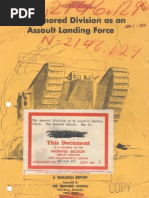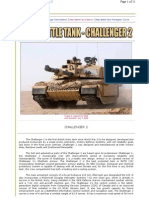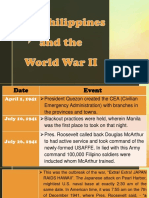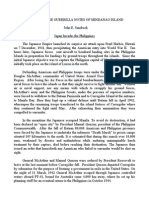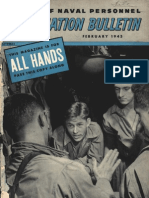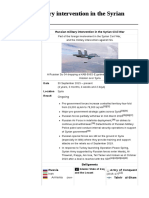World War II: Battle of Bataan: Learn Something New Every Day
World War II: Battle of Bataan: Learn Something New Every Day
Uploaded by
Dmitry Vladimir BelmontCopyright:
Available Formats
World War II: Battle of Bataan: Learn Something New Every Day
World War II: Battle of Bataan: Learn Something New Every Day
Uploaded by
Dmitry Vladimir BelmontOriginal Description:
Original Title
Copyright
Available Formats
Share this document
Did you find this document useful?
Is this content inappropriate?
Copyright:
Available Formats
World War II: Battle of Bataan: Learn Something New Every Day
World War II: Battle of Bataan: Learn Something New Every Day
Uploaded by
Dmitry Vladimir BelmontCopyright:
Available Formats
Humanities › History & Culture
World War II: Battle
of Bataan
Share
SHARE Flipboard
FLIP Email
Japanese tank moving forward on Bataan. Without anti-tank
weapons, the PACR was helpless to stop an armored attack.
Ad
U.S.A.F. - Public Domain/ Wikimedia Commons
by Kennedy Hickman
Updated January 26, 2019
Battle of Bataan - Conflict & Dates:
The Battle of Bataan was fought January 7 to
April 9, 1942, during World War II (1939-
1945).
Forces & Commanders
Allies
Advertisement
General Douglas MacArthur
Lieutenant General Jonathan Wainwright
Major General Edward King
79,500 men
Japanese
Lieutenant General Masaharu Homma
75,000 men
Battle of Bataan - Background:
Following the attack on Pearl Harbor on
December 7, 1941, Japanese aircraft began
conducting an aerial assault on American
forces in the Philippines. In addition, troops
moved against Allied positions on Hong Kong
and Wake Island. In the Philippines, General
Douglas MacArthur, commanding United
States Army Forces in the Far East (USAFFE),
began making preparations to defend the
archipelago from the inevitable Japanese
invasion. This included calling up numerous
Filipino reserve divisions. Though MacArthur
initially sought to defend the entire island of
Luzon, prewar War Plan Orange 3 (WPO-3)
called for USAFFE to withdraw to the highly
defensible ground of the Bataan Peninsula,
west of Manila, where it would hold out until
relieved by the US Navy.
Due to the losses sustained at Pearl Harbor,
this was unlikely to occur.
Battle of Bataan - The Japanese
Land:
On December 12, Japanese forces began
landing at Legaspi in southern Luzon. This was
followed by a larger effort in the north at
Lingayen Gulf on December 22. Coming
ashore, elements of Lieutenant General
Masaharu Homma's 14th Army began driving
south against Major General Jonathan
Wainwright's Northern Luzon Force. Two days
after the landings at Lingayen commenced,
MacArthur invoked WPO-3 and began shifting
supplies to Bataan while Major General George
M. Parker prepared the peninsula's defenses.
Steadily pushed back, Wainwright retreated
through a succession of defensive lines over the
next week. To the south, Major General Albert
Jones' Southern Luzon Force fared little better.
Concerned about Wainwright's ability to keep
the road to Bataan open, MacArthur directed
Jones to move around Manila, which had been
declared an open city, on December 30.
Crossing the Pampanga River on January 1, the
SLF moved towards Bataan while Wainwright
desperately held a line between Borac and
Guagua. On January 4, Wainwright began
retreating towards Bataan and three days later
USAFFE forces were within the peninsula's
defenses.
Battle of Bataan - The Allies
Prepare:
Stretching from north to south, the Bataan
Peninsula is mountainous down its spine with
Mount Natib in the north and the Mariveles
Mountains in the south. Covered in jungle
terrain, the peninsula's lowlands stretch to
cliffs overlooking the South China Sea in west
and beaches in the east along Manila Bay. Due
to the topography, the peninsula's only natural
harbor is Mariveles at its southern tip. As
USAFFE forces assumed their defensive
position, roads on the peninsula were limited a
perimeter route that ran along the east coast
from Abucay to Mariveles and then north up
the west coast to Mauban and an east-west
route between Pilar and Bagac.
Defense of Bataan was divided between two
new formations, Wainwright's I Corps in the
west and Parker's II Corps in the east. These
held a line stretching from Mauban east to
Abucay. Due to the open nature of the ground
around Abucay, fortifications were stronger in
Parker's sector. Both corps commanders
anchored their lines on Mount Natib, though
the mountain's rugged terrain prevented them
from being in direct contact forcing the gap to
be covered by patrols.
Learn Something New Every
Day
Discover surprising insights and little-known
facts about politics, literature, science, and the
marvels of the natural world.
ONE-TAP SIGN UP
Battle of Bataan - The Japanese
Attack:
Though the USAFFE was supported by a large
amount of artillery, its position was weakened
due to a tenuous supply situation. The speed of
the Japanese advance had prevented the large
scale stockpiling of supplies and the number of
troops and civilians on the peninsula exceeded
prewar estimates. As Homma prepared to
attack, MacArthur repeatedly lobbied leaders
in Washington, DC for reinforcements and aid.
On January 9, Lieutenant General Akira Nara
opened the assault on Bataan when his troops
advanced on Parker's lines.
Turning back the enemy, II Corps endured
heavy attacks for the next five days. By the
15th, Parker, who had committed his reserves,
requested assistance from MacArthur.
Anticipating this, MacArthur had already put
the 31st Division (Philippine Army) and
Philippine Division in motion towards II
Corps' sector.
The following day, Parker attempted to
counterattack with the 51st Division (PA).
Though initially successful, the division later
broke allowing the Japanese to threaten II
Corps' line. On January 17, Parker desperately
attempted to restore his position. Mounting a
series of attacks over the next five days, he
managed to retake much of the lost ground.
This success proved brief as intense Japanese
air attacks and artillery forced II Corps back.
By the 22nd, Parker's left was under threat as
enemy forces moved through the rough terrain
of Mount Natib.
That night, he received orders to retreat south.
To the west, Wainwright's corps fared
somewhat better against troops led by Major
General Naoki Kimura. Holding off the
Japanese at first, the situation changed on
January 19 when Japanese forces infiltrated
behind his lines cutting off supplies to the 1st
Regular Division (PA). When efforts to
dislodge this force failed, the division was
withdrawn and lost most of its artillery in the
process.
Battle of Bataan - Bagac-Orion
Line:
With the collapse of the Abucay-Mauban Line,
USAFFE established a new position running
from Bagac to Orion on January 26. A shorter
line, it was dwarfed by the heights of Mount
Samat which provided the Allies with an
observation post overseeing the entire front.
Though in a strong position, MacArthur's
forces suffered from a lack of capable officers
and reserve forces were minimal. As fighting
had raged to the north, Kimura dispatched
amphibious forces to land on the southwest
coast of the peninsula.
Coming ashore at Quinauan and Longoskayan
Points on the night of January 23, the
Japanese were contained but not defeated.
Seeking to exploit this, Lieutenant General
Susumu Morioka, who had superseded
Kimura, dispatched reinforcements to
Quinauan on the night of the 26th. Becoming
lost, they instead established a foothold on
Canas Point. Obtaining additional troops on
January 27, Wainwright eliminated the
Longoskayan and Quinauan threats.
Tenaciously defending Canas Point, the
Japanese were not expelled until February 13.
As the Battle of the Points raged, Morioka and
Nara continued assaults on the main USAFFE
line. While attacks on Parker's corps were
turned back in heavy fighting between January
27 and 31, Japanese forces succeeded in
breaching Wainwright's line via the Toul River.
Quickly closing this gap, he isolated the
attackers into three pockets which were
reduced by February 15. As Wainwright was
dealing with this threat, a reluctant Homma
accepted that he lacked the forces to break
MacArthur's defenses.
As a result, he ordered his men to fall back to a
defensive line on February 8 to await
reinforcements. Though a victory that boosted
morale, USAFFE continued to suffer from a
critical shortage of key supplies. With the
situation temporarily stabilized efforts
continued to relieve the forces on Bataan and
the fortress island of Corregidor to the south.
These were largely unsuccessful as only three
ships were able to run the Japanese blockade
while submarines and aircraft lacked the
carrying capacity to bring the needed
quantities.
Battle of Bataan - Reorganization:
In February, the leadership in Washington
began to believe that USAFFE was doomed.
Unwilling to lose a commander of MacArthur's
skill and prominence, President Franklin D.
Roosevelt ordered him to evacuate to
Australia. Reluctantly leaving on March 12,
MacArthur traveled to Mindanao by PT boat
before flying to Australia on a B-17 Flying
Fortress. With his departure, USAFFE was
reorganized into the United States Forces in
the Philippines (USFIP) with Wainwright in
overall command. Leadership on Bataan
passed to Major General Edward P.
King. Though March saw efforts to better train
USFIP forces, disease and malnutrition badly
depleted the ranks. By April 1, Wainwright's
men were living on quarter rations.
Battle of Bataan - Fall:
To the north, Homma took February and
March to refit and reinforce his army. As it
regained strength, it began to intensify artillery
bombardments of the USFIP lines. On April 3,
Japanese artillery unleashed the most intense
shelling of the campaign. Later in the day,
Homma ordered a massive assault on the 41st
Division (PA)'s position. Part of II Corps, the
41st was effectively broken by the artillery
bombardment and offered little resistance to
the Japanese advance. Overestimating King's
strength, Homma moved forward cautiously.
Over the next two days, Parker fought
desperately to save his crumbling left as King
attempted to counterattack north. As II Corps
was overwhelmed, I Corps began falling back
on the night of April 8. Later that day, seeing
that further resistance would be hopeless, King
reached out to the Japanese for terms. Meeting
with Major General Kameichiro Nagano the
next day, he surrendered the forces on Bataan.
Battle of Bataan - Aftermath:
Though pleased that Bataan had finally fallen,
Homma was angry that the surrender did not
include the USFIP forces on Corregidor and
elsewhere in the Philippines. Massing his
troops, he landed on Corregidor on May 5 and
captured the island in two days of fighting.
With the fall of Corregidor, Wainwright
surrendered all remaining forces in the
Philippines. In the fighting on Bataan,
American and Filipino forces sustained around
10,000 killed and 20,000 wounded while the
Japanese sustained approximately 7,000 killed
and 12,000 wounded.
In addition to the casualties, USFIP lost 12,000
American and 63,000 Filipino soldiers as
prisoners. Though suffering from combat
wounds, disease, and malnutrition, these
prisoners were marched north to prisoner of
war camps in what became known as the
Bataan Death March. Lacking food and water,
prisoners were beaten or bayoneted if they fell
behind or were unable to walk. Thousands of
USFIP prisoners died before reaching the
camps. Following the war, Homma was
convicted of war crimes relating to the march
and was executed on April 3, 1946.
Selected Sources:
Corregidor Historical Society: Bataan
HistoryNet: Battle of Bataan - Brigadier General Clyde
A. Selleck Commands the Layac Line
US Army: Bataan Death March
Article
Last Stand: Battle of Corregidor
Article
World War II: Battle of Guadalcanal
Article
A Bloody Affair: The Battle of
Peleliu
Article
A Black Christmas: Battle of Hong
Kong
Article
What You Need to Know About The
Battle of Monte Cassino
Article
How the Allies Won the Pacific with
Island Hopping
List
Amazing Pictures of World War II in
the Pacific
Article
A Bloody Fight: The Battle of Saipan
in WWII
Article
Battle of Okinawa: The Last Fight in
the Pacific
Article
World War II Pacific: New Guinea,
Burma, & China
Article
Battle of the Bulge: Germany's Last
Major Offensive of World War II
Article
Java Sea: Allies in Retreat
Article
World War II: Battle of Kwajalein
Article
World War II Pacific: Turning Points
in the Pacific
Article
Grinding Out a Victory: Battle of
Caen
Article
Making History: The Battle of the
Coral Sea
Learn Something New Every Day
Discover surprising insights and little-
known facts about politics, literature,
science, and the marvels of the natural
world.
ONE-TAP SIGN UP
Follow Us
Science, Tech, Math Humanities
Arts, Music, Resources
Recreation
About Us Advertise
Privacy Policy Cookie Policy
Careers Editorial Guidelines
Contact Terms of Use
ThoughtCo is part of the Dotdash publishing family.
Verywell Family | Verywell Mind | The Balance
Lifewire and more
You might also like
- Armored Division As An Assault Landing ForceDocument152 pagesArmored Division As An Assault Landing ForceDownfall1100% (2)
- OTO Vulcano 155 LQ Mm08723Document2 pagesOTO Vulcano 155 LQ Mm08723tomay777No ratings yet
- Challenger 2 Modern Battle TankDocument11 pagesChallenger 2 Modern Battle TankMeor Amri100% (3)
- The Battle of BataanDocument9 pagesThe Battle of BataanJack Daniel CandelarioNo ratings yet
- Bataan Has FallenDocument4 pagesBataan Has Fallenmilady ekaNo ratings yet
- BataanDocument4 pagesBataanGenesis Adam De GuzmanNo ratings yet
- WW2Document3 pagesWW2CAMBNo ratings yet
- Bloody War With Japanese InvadersDocument3 pagesBloody War With Japanese InvadersRachelle Danya Dela RosaNo ratings yet
- DocumentDocument1 pageDocumentgloren abutalNo ratings yet
- PPTDocument22 pagesPPTAnne Marie Angelica Bilono100% (1)
- The Battle of Tinian: The Capture of the Atomic Bomb Island, July-August 1944From EverandThe Battle of Tinian: The Capture of the Atomic Bomb Island, July-August 1944No ratings yet
- RARO, Jeson C. GED121 October 6, 2019 Bsac Hmws Japanese Occupation in The PhilippinesDocument2 pagesRARO, Jeson C. GED121 October 6, 2019 Bsac Hmws Japanese Occupation in The PhilippinesViolet PandaNo ratings yet
- Bataan Death March HISTORY RESEARCHDocument2 pagesBataan Death March HISTORY RESEARCHJyNo ratings yet
- Defense of BataanDocument27 pagesDefense of BataanMarjhun LaguillesNo ratings yet
- The Battle of Leyte Gulf The History and Legacy of World War IIs Largest Naval BattleDocument68 pagesThe Battle of Leyte Gulf The History and Legacy of World War IIs Largest Naval BattleMarlon Manaya Garrigues100% (4)
- Mcarthur Landing in PangasinanDocument3 pagesMcarthur Landing in PangasinanNathan ScottNo ratings yet
- Bataan Death MarchDocument48 pagesBataan Death MarchJosefantastic 75No ratings yet
- The Fall of BataanDocument2 pagesThe Fall of BataanAnonymous HH3c17osNo ratings yet
- REPORT (Japanese Remnants)Document18 pagesREPORT (Japanese Remnants)Shem Aldrich R. BalladaresNo ratings yet
- Bataan Death MarchDocument1 pageBataan Death MarchHasz RonquilloNo ratings yet
- Warrior Dennis Masa'ao MolintasDocument9 pagesWarrior Dennis Masa'ao MolintasYtt Quaesitum ResearchNo ratings yet
- Legacy of HeroesDocument1 pageLegacy of HeroesSerenity GreyNo ratings yet
- A Legacy of Heroes: The Story of Bataan and Corregidor: Group 6: Aton, Barnes, Malla, PastoresDocument21 pagesA Legacy of Heroes: The Story of Bataan and Corregidor: Group 6: Aton, Barnes, Malla, PastoresVon Edrick RondaelNo ratings yet
- Japanese HegemonyDocument9 pagesJapanese Hegemonyjanegrace.hernandezNo ratings yet
- New Guinea: The Allied Jungle Campaign in World War IIFrom EverandNew Guinea: The Allied Jungle Campaign in World War IIRating: 5 out of 5 stars5/5 (1)
- Rising Sun in The Pearl of The OrientDocument14 pagesRising Sun in The Pearl of The OrientReymond OloganNo ratings yet
- The Return ofDocument29 pagesThe Return ofLorjean DucaNo ratings yet
- Attack On Pearl Harbour: Japanese Occupation and The War YearsDocument3 pagesAttack On Pearl Harbour: Japanese Occupation and The War YearsAilynne Joy Rojas LimNo ratings yet
- Japanese Occupation - Rape of ManilaDocument2 pagesJapanese Occupation - Rape of ManilaMCDABCNo ratings yet
- Battle of ManilaDocument58 pagesBattle of ManilaCram Naj Rotse OnairutNo ratings yet
- Japanese OccupationDocument38 pagesJapanese Occupationsantillan.blanchvenice.cstrNo ratings yet
- Bataan Death MarchDocument2 pagesBataan Death MarchYdnar Christian BaldelovarNo ratings yet
- Bataan Death MarchDocument2 pagesBataan Death MarchAL CaleNo ratings yet
- Japanese Occupation in The PhilippinesDocument44 pagesJapanese Occupation in The Philippineslt castroNo ratings yet
- Mcarthur Landing in PangasinanDocument3 pagesMcarthur Landing in PangasinanNathan ScottNo ratings yet
- Douglas MacArthur's Escape From The PhilippinesDocument11 pagesDouglas MacArthur's Escape From The Philippines田中将大0% (1)
- The Marshall Islands 1944: Operation Flintlock, the capture of Kwajalein and EniwetokFrom EverandThe Marshall Islands 1944: Operation Flintlock, the capture of Kwajalein and EniwetokRating: 1 out of 5 stars1/5 (1)
- Rcdig1070439 - 1-G. Hermon Gill 23 Australians at Taraka NDocument9 pagesRcdig1070439 - 1-G. Hermon Gill 23 Australians at Taraka Niii_333No ratings yet
- Filipino History 01 Japanese InvasionDocument68 pagesFilipino History 01 Japanese InvasionXierre ScarletNo ratings yet
- Liberation of PanayDocument6 pagesLiberation of PanayElizabeth CastroNo ratings yet
- Japanese Occupation in The PhilippinesDocument44 pagesJapanese Occupation in The Philippineslt castroNo ratings yet
- Fall of BataanDocument9 pagesFall of BataanIsabel HigginsNo ratings yet
- World War II Group Research On NihongoDocument30 pagesWorld War II Group Research On NihongoCj AndersonNo ratings yet
- The Mindanao Island During The Japanese Occupation - An Insight by The Philippine Guerilla MovementDocument27 pagesThe Mindanao Island During The Japanese Occupation - An Insight by The Philippine Guerilla MovementJacobPadillaNo ratings yet
- Securing The Surrender-Marines in The Occupation of JapanDocument49 pagesSecuring The Surrender-Marines in The Occupation of JapanBob AndrepontNo ratings yet
- Part 6Document11 pagesPart 6Joella Mariel De GuzmanNo ratings yet
- Japanese OccupationDocument5 pagesJapanese OccupationJo RinzNo ratings yet
- Riph - Bataan VS CorregidorDocument1 pageRiph - Bataan VS Corregidoramethys manuelNo ratings yet
- All Hands Naval Bulletin - Feb 1945Document84 pagesAll Hands Naval Bulletin - Feb 1945CAP History LibraryNo ratings yet
- The Battle Agaisnt The Oppressors - 073412Document27 pagesThe Battle Agaisnt The Oppressors - 073412Jiemalyn Asis Gregorio100% (1)
- D-Day EssayDocument2 pagesD-Day Essayapi-439032909No ratings yet
- The History of The U.S. Army Corps of EngineersDocument163 pagesThe History of The U.S. Army Corps of EngineersBob Andrepont75% (4)
- NZ Divisional Cavalry Regiment, September 1944Document7 pagesNZ Divisional Cavalry Regiment, September 1944Hauke KrapfNo ratings yet
- Pancho Villa Capture Expedition Pershing ReportDocument117 pagesPancho Villa Capture Expedition Pershing ReportReidezel Mendoza Soriano100% (2)
- Outlook Newspaper - 18 June 2009 - United States Army Garrison Vicenza - Caserma, Ederle, ItalyDocument8 pagesOutlook Newspaper - 18 June 2009 - United States Army Garrison Vicenza - Caserma, Ederle, ItalyUS Army AfricaNo ratings yet
- Bastille Day Military ParadeDocument7 pagesBastille Day Military ParadeGeorgiaNo ratings yet
- Electronic Warfare: Call Us Today: +1-972-665-9786Document27 pagesElectronic Warfare: Call Us Today: +1-972-665-9786Myo Nyunt WinNo ratings yet
- Us Naval DirectoryDocument8 pagesUs Naval DirectoryEddie Goynes JrNo ratings yet
- Taiwan - NavyDocument22 pagesTaiwan - NavyDarmawan Wijaksono100% (1)
- GEHLEN Reinhard CIA File VOL 3Document267 pagesGEHLEN Reinhard CIA File VOL 3channel view100% (1)
- Duritium GT: Advanced Body Armor Plates With Green Tip ProtectionDocument2 pagesDuritium GT: Advanced Body Armor Plates With Green Tip Protectiont1tacalNo ratings yet
- Us Army CC It0458 Introduction To Imagery AnalysisDocument141 pagesUs Army CC It0458 Introduction To Imagery AnalysisDaryl Pennington100% (1)
- Structure of The Pakistan Army - Wikipedia PDFDocument37 pagesStructure of The Pakistan Army - Wikipedia PDFAmmar AhmadNo ratings yet
- AFV101 ScorpionDocument9 pagesAFV101 ScorpionBig ZamNo ratings yet
- BMW 13Document3 pagesBMW 13blackhair008No ratings yet
- NCC Army Specialised Eng. 2019-20 by NCC GuruDocument105 pagesNCC Army Specialised Eng. 2019-20 by NCC Gurubraja743245No ratings yet
- The Delta of The Triple ElevensDocument118 pagesThe Delta of The Triple ElevensGutenberg.orgNo ratings yet
- Western Front Tank Leader Errata and Updates ChartsDocument2 pagesWestern Front Tank Leader Errata and Updates ChartsILuvLANo ratings yet
- Examples of The Complexity of Continental Army Unit Lineage: (The Virginia, Pennsylvania and Massachusetts Continental Lines)Document31 pagesExamples of The Complexity of Continental Army Unit Lineage: (The Virginia, Pennsylvania and Massachusetts Continental Lines)John U. Rees100% (3)
- Brief Introduction: "A Glimpse of The Battlefield: A Hero From The Air"Document8 pagesBrief Introduction: "A Glimpse of The Battlefield: A Hero From The Air"Vincent NavalNo ratings yet
- MCRP 3-12.1 Tank PlatoonDocument380 pagesMCRP 3-12.1 Tank PlatoonBenjamin David Spaeth100% (1)
- DVPL File Info CacheDocument1,531 pagesDVPL File Info CacheMohd Hairulnizam Bin HussinNo ratings yet
- Russian Military Intervention in The Syrian Civil War PDFDocument62 pagesRussian Military Intervention in The Syrian Civil War PDFMendiburuFranciscoNo ratings yet
- Da Pam 385Document13 pagesDa Pam 385Negrea PaulNo ratings yet
- Byzantine Land Forces - BasicsDocument21 pagesByzantine Land Forces - BasicsJustinian WilliamsNo ratings yet
- Electronic Counter-CountermeasureDocument4 pagesElectronic Counter-CountermeasureCarlos Eduardo de SouzaNo ratings yet
- Air To SurfaceDocument7 pagesAir To SurfaceHVNo ratings yet
